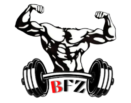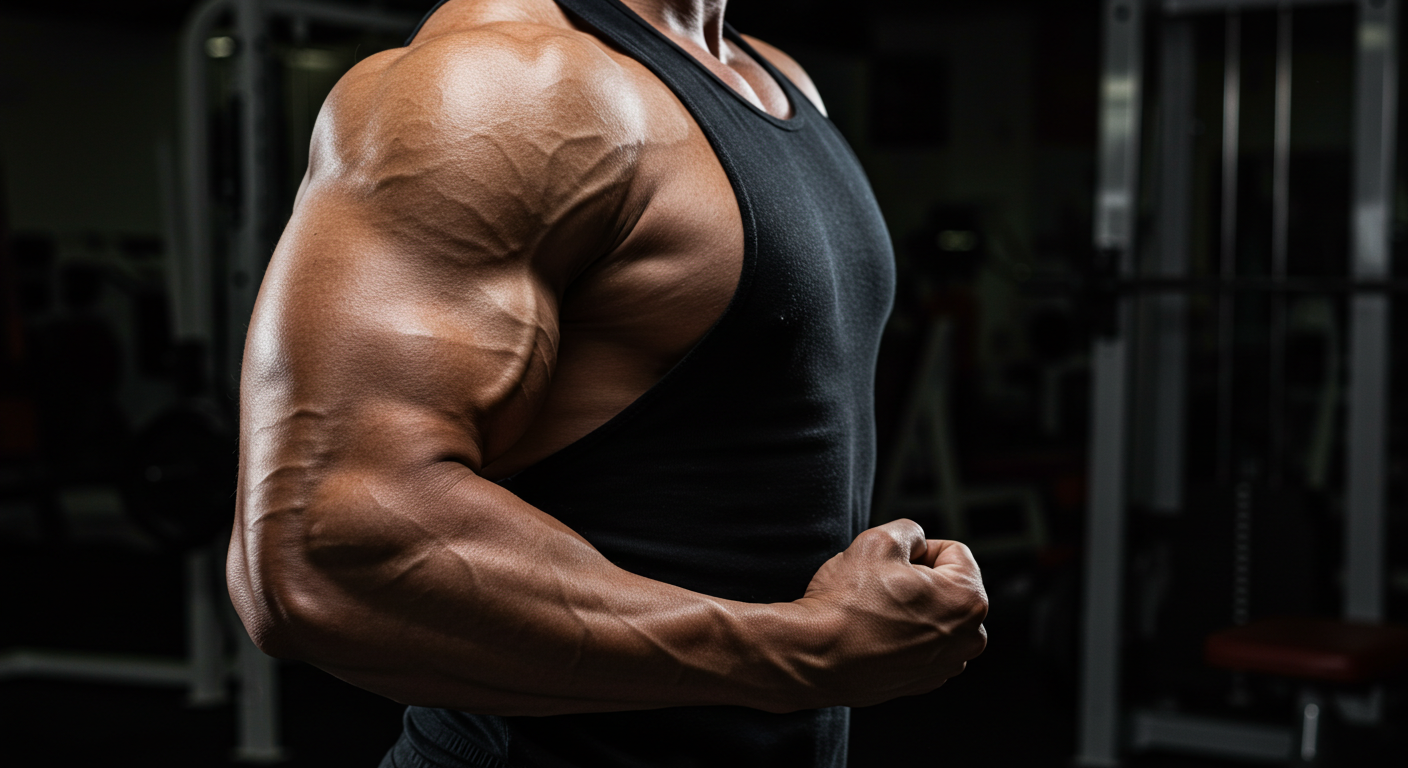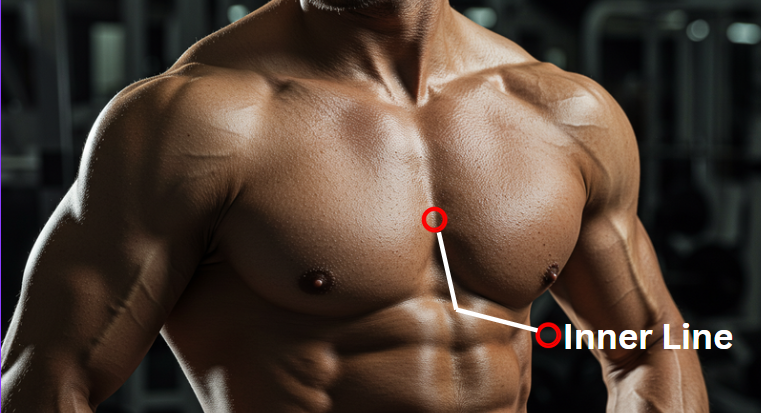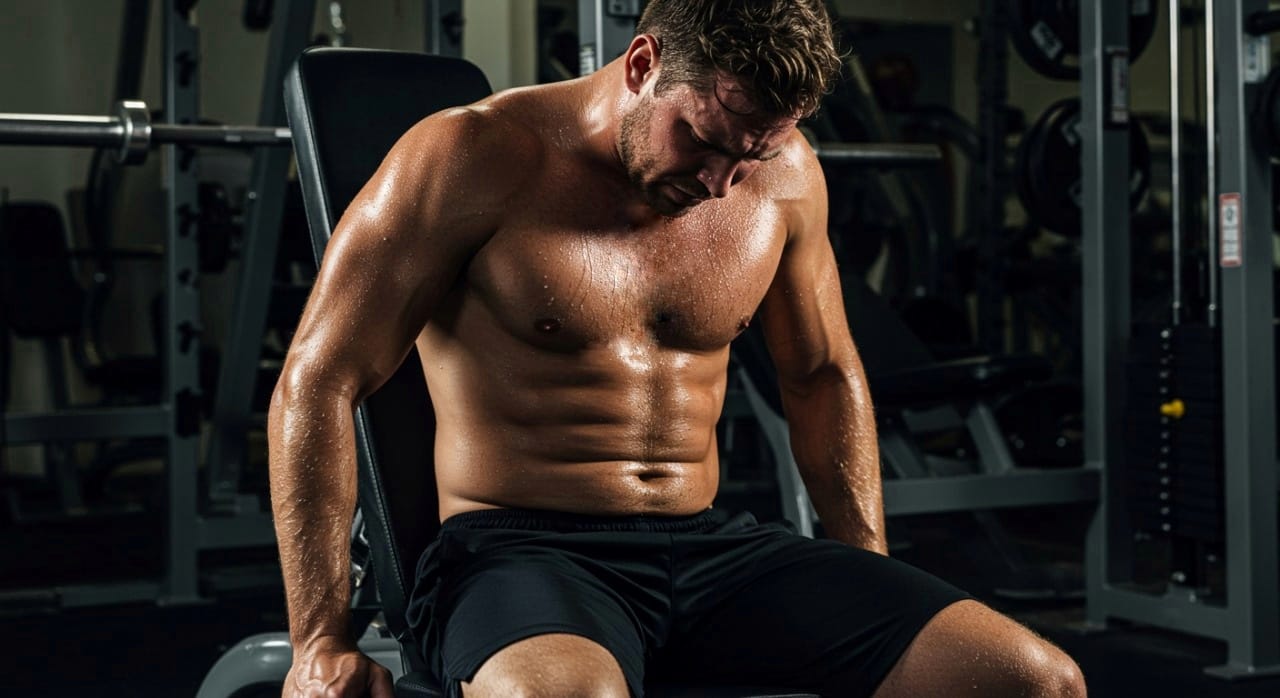The chest, one of the most attractive parts of a man’s physique, is a muscle that remains visible even when you’re wearing clothes. If you look at most fitness enthusiasts, their chest often appears incomplete—like a brick missing from a castle. What’s missing? The upper chest, the final touch for a sculpted look.

Chest day is everyone’s favorite workout session, but people often stick to exercises like the flat bench press, chest fly, and chest dip. While these compound movements are effective, they primarily target the lower and middle pecs, with minimal stimulation to the upper part.
However, you need to understand that the upper chest is the most stubborn muscle in the chest and is notoriously hard to grow. Many people commonly complain that their upper chest is not developing properly, and they’re right. The reason is a lack of isolated training for the upper chest. To achieve a well-sculpted chest, you must prioritize your upper pecs. When you focus on training the upper pecs, you not only improve aesthetics but also enhance shoulder stability, which reduces the risk of injury.
In this article, you’ll learn about the best isolation exercises for the upper chest, along with important tips to help your upper pecs grow faster. You’ll also find examples of chest routines to achieve quick results.
Upper Chest Anatomy
The upper chest is the upper portion of the pectoralis major, located at the top of the chest on the clavicular head muscle, which is why it is also called the clavicular head. It originates from the clavicle, runs across the upper chest, and connects to the humerus bone.

The pectoralis muscle is large, and the upper chest forms a smaller part of the pectoralis major. This muscle aids in shoulder movement and can be targeted through arm-pushing and lifting movements.
Prioritize the Upper Pecs First
A major reason your upper pecs might not be growing is that you’re not prioritizing them. Always remember that muscles don’t grow if they aren’t getting enough stimulation and focus. The only way to improve a lagging muscle is to give it the highest intensity and effort, which is only possible when you’re fresh.
When you enter the gym and complete your warm-up and stretching, you are fresh and energetic, with the ability to give your best effort. The exercise you start with typically consumes the most energy and provides the highest muscle activation. This is crucial for growing a lagging muscle and ensuring you get the maximum benefit from the exercise.
So, next time it’s chest day, make sure to start with your upper chest workout.
Train Twice a Week
This advice applies not only to your chest but to every muscle group. When it comes to stubborn muscles like the upper chest, it’s highly recommended to train them at least twice a week using isolation movements. Incorporate different workouts to target the muscles from various angles.
A weekly volume of 15–20 sets is ideal for growing underdeveloped muscles. However, don’t try to cram all these sets into a single workout session—it will be disastrous for your body. Overloading increases the risk of injury and can hinder muscle growth.
Instead of performing all those sets in one session, split your chest workouts into two separate days. Include the exercises you learn here into your routine. This approach allows you to complete 15–20 sets per week in a more manageable way, without overwhelming your muscles.
By training twice a week, your chest gets enough stimulation and adequate recovery time between sessions to grow and become bigger. Isolated training for the upper chest lets you focus on improving its strength while spreading out the workload. This approach helps you build well-tuned muscles and refine your technique for better results quickly.
Best Upper Chest Exercise
- Decline pushups
- Reverse grip bench press
- Landmine chest press
- Low to high chest fly
- Incline hammer press
- Incline cable fly
- Incline bench press (dumbbell or barbell)
Decline Push-Up

The push-up is a basic yet effective compound exercise. By simply adjusting the angle, you can target different muscles in your chest. The decline push-up is one variation that targets the clavicular head, or the upper chest muscle. It is a highly effective exercise for activating and developing the upper pec, leading to significant muscle growth. This exercise not only tones your muscles but also enhances your strength and stability.
How to Perform
- Find a flat surface such as a bench, chair, or step. Ensure that when you place your toes on the surface, your body remains parallel to the ground.
- Place your hands on the floor, slightly wider than shoulder-width apart. Fully extend your arms, and position your feet on the surface behind you. Ensure your body forms a straight line.
- Engage your core by tightening your abdominal muscles. This helps maintain a straight posture throughout the exercise.
- Slowly lower your chest toward the ground by bending your elbows. Aim for a 45-degree angle to effectively target your chest and feel the stretch.
- Press your palms into the floor, extend your elbows, and return to the starting position.
- Perform each set to failure and aim for 3 sets.
If the exercise feels too challenging, use a lower surface, but avoid surfaces that are too high, as this will shift the load to your shoulders.
How It Helps
- Targets your upper chest, shoulders, and triceps.
- Improves shoulder stability and strengthens muscles, helping you achieve an aesthetic chest.
- Enhances shoulder health, reducing the risk of injury during pushing and pulling movements.
Reverse Grip Bench Press

This is another primary exercise, but switching to an underhand grip specifically targets your upper chest. While the traditional grip focuses more on the mid and lower chest, changing the grip angle shifts the load toward your upper pecs. Select a weight appropriate to your ability—ego lifting is not advised, especially if your wrists are not strong enough, as this may lead to injury.
How to Perform
- Start by using a bench press machine, which is available in most gyms.
- Lie down on the flat bench, creating an arch in your back for better support.
- Hold the barbell with a reverse grip, meaning your palms should face toward you. The grip should be slightly inside shoulder-width for optimal comfort and effectiveness. Ensure your wrists are in a comfortable position.
- Lift the bar off the rack and fully extend your arms to hold the barbell straight above your chest.
- Slowly lower the barbell toward your chest until it almost touches. Keep your elbows close to your body and focus on feeling the stretch.
- Once you feel a full stretch, push the barbell back up by extending your elbows straight to return to the starting position.
- Breathe in while lowering the barbell and breathe out when pushing it back to the starting position.
- Perform 3 sets of 12–15 reps.
How It Helps
- Targets your upper chest, triceps, and shoulders.
- Stimulates your upper pecs, helping them develop tone and achieve a sculpted chest.
Landmine Chest Press

Though it slightly stimulates the shoulders, the landmine chest press is an innovative exercise that specifically targets the upper chest. Performing the exercise in a landmine position introduces a unique angle of resistance, which helps build the upper chest. It also allows for hand placement adjustments to target different zones of the chest.
How to Perform
- If your gym has a landmine attachment, attach the barbell to it. If not, place a standard or long barbell in a corner, making sure it’s stable and won’t move during the exercise.
- Load the opposite side of the barbell with free weights, adjusting the weight according to your strength. Then, kneel with your body facing away from the landmine, keeping your feet shoulder-width apart.
- Hold the barbell’s loaded side with both hands at chest level.
- Slightly bend your hips and tighten your core muscles to stabilize your body during the exercise.
- Push the barbell up by extending your arms, but do not fully lock them. At the top of the movement, squeeze your upper chest and breathe out.
- Slowly lower the barbell by bending your elbows back toward your chest, returning to the starting position in a controlled manner. Inhale as you lower the bar.
- Aim for 15–20 reps and complete 3–4 sets.
How It Helps
- This exercise targets the chest from a completely unique angle.
- It focuses on the shoulders and upper chest.
- It strengthens shoulder stability and mobility, while toning the upper chest to help create a sculpted look.
Low to High Cable Fly

The low to high cable fly is a highly effective exercise to sculpt your upper pecs. This exercise provides a full stretch due to the flying motion, allowing you to squeeze your muscles, which is optimal for growth. It is a dynamic movement that targets the upper chest, shoulders, and inner chest. It also helps increase upper body strength, flexibility, and shoulder stability.
How to Perform
- Set up a cable machine with the pulleys positioned at knee height, and attach a D-handle to each pulley.
- Hold the handles with each hand and stand in the middle of the pulleys.
- Position your palms facing forward and step slightly forward from the cable to create tension. Place one foot in front of the other for stability.
- Tighten your core, slightly bend your elbows, and start with your arms down, hands aligned with your hips.
- Bring both arms together in front of your chest, squeezing your upper chest as you exhale.
- Slowly lower your hands back down, feeling the stretch, and breathe in.
- Aim for 15–18 reps per set, and complete 3 sets.
How It Helps
- Performing this exercise on a cable machine increases tension significantly, providing a great stretch, which is essential for muscle growth.
- Targets your front deltoids, upper chest, and inner pecs, making it a great exercise for sculpting and defining your chest.
- Improves shoulder stability and strength.
Incline Hammer Press

The incline hammer press is a powerful exercise to build an aesthetic upper chest. If you have any joint pain in your arms, this exercise may be a great choice due to its neutral grip, which reduces stress on your wrists and elbows, making it easier than standard presses.
How to Perform
- Set an adjustable bench to an angle of 25–35 degrees. Avoid setting it too high, as this will shift the load from your upper chest to your shoulders. This angle specifically targets the upper pecs, helping you achieve that sculpted look.
- Sit on the bench, grab a pair of dumbbells in both hands, and maintain an arch in your back. Make sure to lift according to your strength—don’t let ego influence your weight choice.
- Pick the dumbbells up by fully extending your arms, with your palms facing inward. Engage your core muscles to stabilize your body throughout the movement.
- Slowly lower the dumbbells by bending your elbows in a controlled manner. Don’t lower the dumbbells too much—until your upper arms are parallel to the floor—and inhale as you lower the weight.
- Press the dumbbells back to the starting position and exhale as you do so.
- Feel the stretch as you lower the weights, and squeeze your upper chest when the dumbbells are at the top. Keep tension on your chest throughout the movement. Do not rush; controlling the movement is key.
- Aim for 8–12 reps per set, and perform 3–4 sets. Choose a weight that challenges you but allows you to maintain proper form.
How It Helps
- It’s an excellent exercise for stretching and squeezing your upper pec muscles.
- The comfortable grip reduces strain on your wrists and elbows.
- Helps improve strength, balance, and muscle growth.
Incline Cable Fly

To grow your chest, a cable machine is often the best choice due to the constant tension it provides, which you won’t get with other machines or free weights. What makes this exercise especially effective is the angle of the bench, which isolates the upper chest, while the cable machine allows for a full stretch and keeps tension throughout the movement.
How to Perform
- First, adjust the pulleys of the cable machine to the lowest position and attach a D-handle to each pulley.
- Place an incline bench in the center between the cable machines, setting it to an angle of about 25–35 degrees. This angle will effectively target your upper chest.
- Grab a handle with each hand, palms facing inward, and sit down on the incline bench.
- Arch your back slightly and plant your feet firmly on the floor. Extend your arms outward and slightly bend your elbows. This is your starting position.
- Slowly bring your arms together in a wide arc, maintaining a slight bend in your elbows. Squeeze your chest muscles as you breathe out.
- Reverse the movement by returning your arms to the starting position, feeling the stretch as you do, and breathe in.
- Aim for 12–15 reps per set, completing 3 sets.
Try to avoid using momentum throughout the movement and focus on maintaining proper form. Feel the stretch and squeeze, using the mind-muscle connection in your chest with each rep.
How It Helps
- Provides continuous tension and activation on your muscles throughout the movement, helping to tear muscle fibers for growth.
- The incline bench helps prevent swinging and cheating, ensuring proper form.
Incline Bench Press (Dumbbell or Barbell)

The incline bench press is a simple yet essential exercise for growing your upper chest. The incline angle makes this exercise highly effective, and using free weights (dumbbells or a barbell) allows for better flexibility and balanced development.
How to Perform
- Set an adjustable bench to an incline of around 30 degrees.
- Sit on the bench with your back slightly arched, holding a dumbbell in each hand or a barbell, and extend your arms fully to hold the weights above you.
- To stabilize your shoulders, pull your shoulder blades back and squeeze them together.
- Slowly bend your elbows and lower the weights (dumbbells or barbell) to chest level, feeling a full stretch in your muscles as you breathe in.
- Push the weights back up to the starting position, squeezing your chest and breathing out as you do.
- Aim for 12–15 reps per set, completing 3–4 sets.
How It Helps
- An excellent exercise to target the upper portion of your chest and promote balanced development.
- The full range of motion ensures your muscles get a deeper stretch, contraction, and stimulation for growth.
- Using a bench helps reduce the chances of cheating, while dumbbells help stabilize muscles and improve coordination.
Workout Plan 1
• Incline Bench Press (Dumbbell or Barbell) × 3 sets of 8–12 reps
• Low to High Cable Fly × 3 sets of 12–15 reps
• Reverse Grip Bench Press × 3 sets of 10–12 reps
• Decline Pushups × 3 sets to failure
• Incline Hammer Press × 3 sets of 8–10 reps
Workout Plan 2
• Incline Cable Fly × 3 sets of 12–15 reps
• Flat Bench Press (Barbell or Dumbbell) × 4 sets of 8–12 reps
• Landmine Chest Press × 3 sets of 12–15 reps
• Incline Hammer Press × 3 sets of 10–12 reps
• Decline Pushups × 3 sets to failure
These workout plans are designed with both horizontal and vertical movements to train your chest from every angle, ensuring it gets enough stimulation to grow. You can take 60–90 seconds of rest between sets and gradually increase the weight or reps over time to ensure progressive overload. Don’t forget about proper nutrition and rest to maximize muscle growth.
Bench Position
When using an incline angle, the exact angle can be a debated and confusing topic. Studies show that a 30-degree angle targets your upper chest the most. If you go above this angle, the load will gradually shift toward your shoulders. If you go lower than 30 degrees, the load shifts toward your middle and lower chest.
While performing the movement, make sure your back is in a comfortable position. It’s essential to perform the exercise with a full range of motion. Whether you’re using dumbbells or a barbell, be careful about your hand position. Otherwise, you might feel strain and risk injuring your shoulder.
Proper Form and Technique
If you’re new to the gym, ask your trainer or any experienced gym-goer to show you the proper form and technique. When targeting your upper chest, the shoulder is a key part involved, and it’s a sensitive area of your body. Most shoulder injuries occur during training.
It’s rare to find someone who hasn’t struggled to build their upper chest—this is a common challenge among fitness enthusiasts. Keep in mind that for muscle growth, your muscles need enough stimulation, which includes proper stretch, tension, focus, and recovery. This is how muscles grow. It’s essential to prioritize proper form to reduce the risk of injury.
The Bottom Line
If you dream of having a sculpted chest that shows through your clothes, pay more attention to the stubborn area—the upper portion. It requires time, effort, and the right exercises.
To make your upper chest stronger, you need to target it from different angles with progressive overload. Training from both horizontal and vertical angles helps stimulate the muscle effectively. The workout plan above is designed with this approach in mind.
Make sure to hit the chest twice a week, starting with the upper pecs when you’re fresh and energetic. Always maintain proper form, and if needed, seek expert advice. Stay consistent with your goals, and you’ll see your efforts turn into results.






